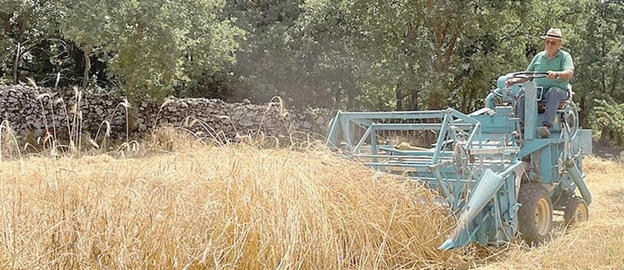Mount Etna is not only known for its fiery eruptions but also as a fertile ground for agricultural experiments. One such endeavor, led by the Serafica family, is the revival of “irmana” rye—a nearly forgotten variety of rye that has deep roots in Sicilian agriculture. Grown at an altitude of nearly 1,000 meters, the Serafica family is the sole custodian of this ancient grain, cultivating five hectares on the southern slopes of Etna in Nicolosi, Catania. This effort is a part of a larger movement to blend tradition with modern innovation in Sicilian farming.
A Resilient Mountain Crop
Irmana rye, like most rye varieties, is known for its resilience in harsh climates, particularly its resistance to cold temperatures, earning it the title “mountain cereal.” It is a low-maintenance crop that thrives without chemical fertilizers or irrigation. Its natural hardiness allows it to outcompete weeds, meaning no herbicides or pest control are needed. These characteristics make it an ideal crop for sustainable agriculture, especially in mountainous regions like Etna.
The Serafica family’s journey with irmana rye began as a small experiment, but thanks to collaboration with the University of Catania, the Etna Park, and the municipality of Nicolosi, this rare grain is now slowly regaining a foothold in Sicilian agriculture. The seeds for irmana rye were rediscovered almost by accident when a farmer in Enna was found to have preserved just half a kilogram of seeds. From this modest beginning, the family has cultivated a new chapter for the crop.
The Market Potential
Today, the five hectares of irmana rye yield approximately 10,000 kilograms of grain, which translates into about 7,000 kilograms of flour. In market terms, this production is valued at around €50,000, though these numbers are expected to grow as demand increases. While few bakers and pizza makers use the flour exclusively, the ones who do, including high-profile chefs like three-star Michelin chef Niko Romito, are putting the spotlight on this forgotten grain. Other notable users of irmana rye include Forno Biancuccia in Catania and the prestigious Hotel San Pietro in Taormina, where chef Luca Miuccio creates artisanal bread and dishes that highlight the uniqueness of this ancient grain.
What sets irmana rye apart is not only its rarity but its distinct flavor and nutritional value. This rye is used to produce “Pane Immanu,” a traditional bread made from a mix of irmana rye flour and durum wheat semolina. The grain’s robustness and unique properties make it particularly well-suited for baking rustic bread with a dense crumb and rich, earthy flavors. With its lower gluten content compared to wheat, irmana rye appeals to modern health-conscious consumers and fits well within trends favoring ancient grains.
The Future of Irmana Rye
The Serafica family’s efforts come at a time when global food trends are shifting towards the rediscovery of ancient grains and traditional agricultural practices. As consumers become more discerning about their food choices, looking for sustainable and unique products, the market for irmana rye is poised to grow. While production is currently limited, increasing demand from high-end chefs and artisan bakers suggests there is room for expansion.
Given its resilience and low environmental impact, irmana rye also offers an opportunity for broader cultivation in other areas with similar climates. As climate change continues to impact global agriculture, crops like rye, which can withstand extreme weather, could become increasingly important for food security.
The Serafica family’s revival of irmana rye is a testament to the power of blending tradition with innovation. This ancient grain, once nearly forgotten, is now gaining recognition not only in Sicily but on the plates of some of Italy’s top chefs. As demand for unique, sustainable grains rises, irmana rye stands to become a key part of Sicily’s agricultural and culinary future. The story of irmana rye serves as a reminder of the value in preserving traditional crops that are perfectly suited to their environments and offer distinct qualities that modern grains cannot replicate.
Error




